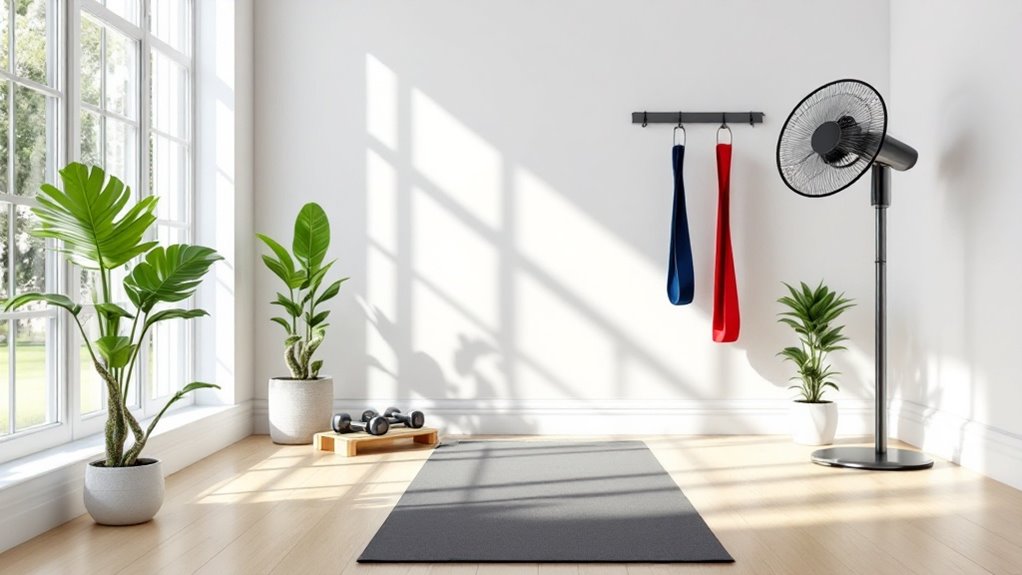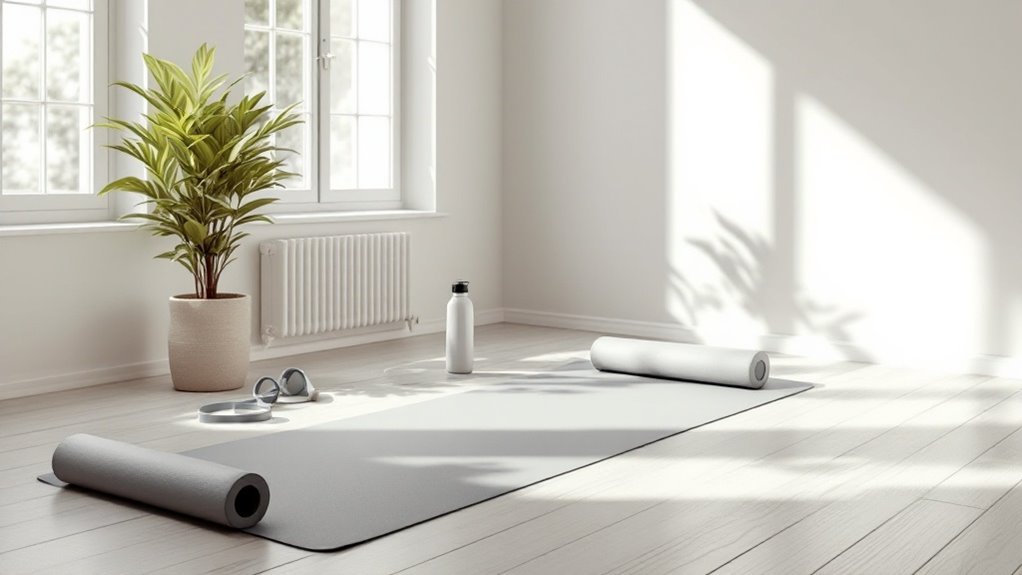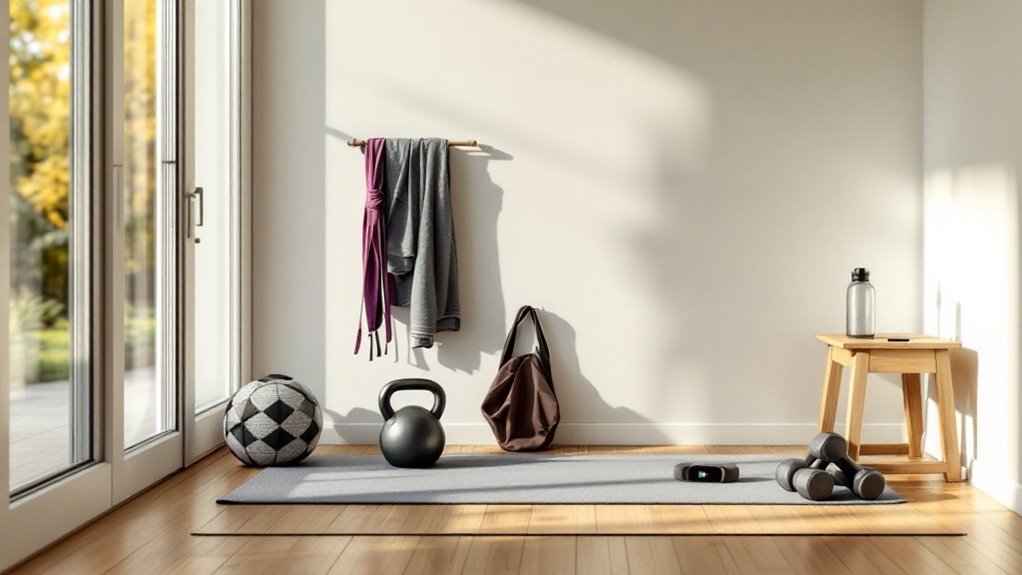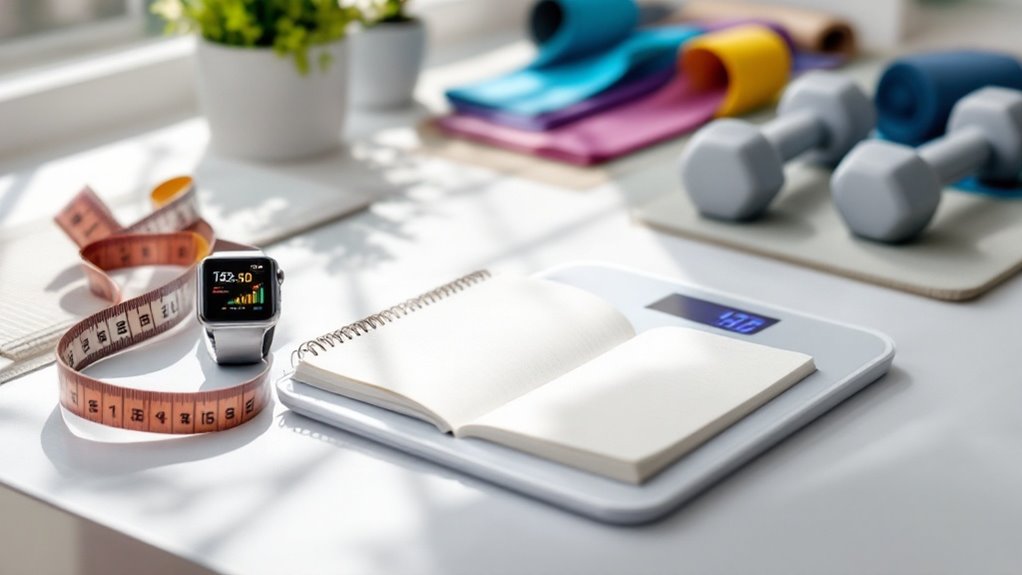Getting Fit at Home

Getting fit at home starts with creating a dedicated workout space equipped with basic gear like resistance bands and a yoga mat. Essential bodyweight exercises including push-ups, squats, and planks form the foundation of an effective routine. Beginners should commit to three 30-minute sessions weekly, alternating between upper body, lower body, and full-body workouts. Tracking progress through measurements and a fitness journal maintains momentum. A structured approach opens the path to sustainable fitness transformation.
Key Takeaways
- Create a dedicated workout space with essential equipment like yoga mat, resistance bands, and adjustable dumbbells.
- Start with bodyweight exercises including push-ups, squats, and planks three times per week for 30-minute sessions.
- Track progress through body measurements, progress photos, and workout logs to maintain motivation and accountability.
- Begin with basic movements and gradually increase intensity by adding more repetitions or reducing rest periods.
- Schedule workouts consistently, alternating between upper body, lower body, and full-body routines to prevent overtraining.
Creating Your Home Workout Space

When starting a fitness journey at home, establishing a dedicated workout space serves as the foundation for success. This space, whether a spare room, garage corner, or living area section, becomes the command center for physical transformation.
The ideal workout area requires three key elements: adequate floor space for movement, proper ventilation, and minimal distractions. Clearing clutter and organizing equipment creates a structured environment that promotes focus and discipline.
A purposeful workout space demands room to move, fresh air to breathe, and freedom from distraction—essentials for achieving fitness success.
Essential equipment starts basic: a yoga mat, resistance bands, and adjustable dumbbells. As fitness levels advance, additional gear can be incorporated strategically.
The goal is creating an environment that inspires consistent action and delivers results.
Implementing progressive overload training through gradual equipment additions helps ensure continued strength gains and muscle development.
Essential Bodyweight Exercises for Every Fitness Level

Every successful fitness journey begins with mastering fundamental bodyweight exercises that build strength, stability, and proper form.
These exercises provide the foundation for progressive fitness development while requiring no equipment, making them ideal for home workouts.
- Push-ups target upper body strength, engaging chest, shoulders, and core muscles while developing proper plank positioning.
- Squats build lower body power and improve mobility through the hips, knees, and ankles.
- Planks strengthen the core, promote better posture, and improve overall stability.
- Mountain climbers combine cardio with strength training, boosting endurance while engaging multiple muscle groups.
Starting with 2-3 weekly sessions allows beginners to build consistency while minimizing the risk of overtraining or burnout.
Building an Effective Home Exercise Schedule

Three key elements transform a collection of exercises into a sustainable home fitness routine: proper scheduling, balanced intensity, and strategic progression.
For peak results, beginners should start with three 30-minute sessions per week, allowing rest days between workouts. Morning sessions boost metabolism and guarantee consistency, while evening workouts can help release daily stress.
Alternating between upper body, lower body, and full-body routines prevents overtraining specific muscle groups.
Smart exercise rotation allows muscles proper recovery time while maintaining consistent training momentum throughout the week.
Track progress using a simple workout log, noting repetitions, duration, and perceived effort. Adjust intensity every two weeks by increasing repetitions or reducing rest periods.
This systematic approach builds lasting habits while minimizing injury risk.
Incorporate weight machine exercises gradually once you've mastered bodyweight movements to enhance strength gains and muscle development.
Tracking Progress and Staying Motivated

Successful fitness journeys thrive on measurable progress and sustained motivation. Tracking physical changes and maintaining enthusiasm are essential elements for achieving long-term fitness goals at home.
A systematic approach to monitoring advancement helps individuals stay focused and committed to their exercise routines.
- Record key metrics weekly: body measurements, weight, progress photos, and workout performance
- Use a fitness journal or mobile app to document exercises, sets, and personal records
- Set specific micro-goals that build toward larger fitness objectives
- Create accountability through social media updates or virtual workout partners
These tracking methods provide tangible evidence of improvement while fostering the motivation needed to maintain consistent effort in home-based fitness programs.
While transformative results take time, incorporating high-intensity interval training into your routine can accelerate initial fitness gains within two weeks.
Frequently Asked Questions
What Exercises Can I Do if I Have Downstairs Neighbors Who Complain About Noise?
Low-impact exercises minimize noise while maximizing results. One can perform yoga flows, planks, wall sits, push-ups, and resistance band workouts.
Standing exercises like bicep curls, shoulder presses, and bodyweight squats work well. Static holds and isometric exercises remain silent yet effective.
For cardio, switch to low-impact alternatives like shadowboxing, tai chi movements, or slow controlled lunges.
How Long Should I Wait After Eating Before Starting My Home Workout?
Like a well-oiled machine, the body needs proper timing to perform at its peak.
For most exercises, waiting 2-3 hours after a large meal allows ideal digestion and prevents discomfort. Light snacks require 30-60 minutes.
Morning warriors can exercise on an empty stomach, while those training later should time meals strategically.
Blood flow diverted to digestion can impact workout performance and potentially cause cramps.
Can I Get the Same Results at Home as I Would at the Gym?
Achieving comparable results at home versus the gym is absolutely possible with proper dedication and programming.
While gyms offer extensive equipment, home workouts can be equally effective through bodyweight exercises, resistance bands, and basic equipment like dumbbells.
The key factors are consistency, progressive overload, and proper form – not location.
Many athletes have built impressive physiques through home training, proving that commitment matters more than facility.
What Are the Best Alternatives When Recovering From an Exercise-Related Injury at Home?
Recovery from exercise injuries requires smart alternatives that maintain fitness while promoting healing. Key options include low-impact cardio like swimming or stationary cycling, modified bodyweight exercises avoiding the injured area, and targeted mobility work.
Physical therapy exercises, gentle stretching, and resistance band training can aid rehabilitation. Rest periods should be balanced with appropriate movement to prevent muscle loss and maintain conditioning.
Should I Work Out at the Same Time Every Day or Vary My Schedule?
Like a well-oiled machine, the body thrives on routine and predictability. Exercising at a consistent time helps establish a sustainable fitness habit by coordinating with the body's natural circadian rhythm.
However, life's demands may require flexibility. The key is maintaining consistency in frequency rather than exact timing.
Research shows both approaches can be effective, but a regular schedule typically leads to better adherence and long-term success.
Final Thoughts
With determination and consistency, anyone can achieve their fitness goals without leaving home. Creating a dedicated workout space, mastering fundamental bodyweight exercises, following a structured schedule, and monitoring progress are the cornerstones of success. While the path may seem like an uphill battle at first, establishing healthy habits and celebrating small victories will light the way toward lasting physical transformation and improved wellbeing.


